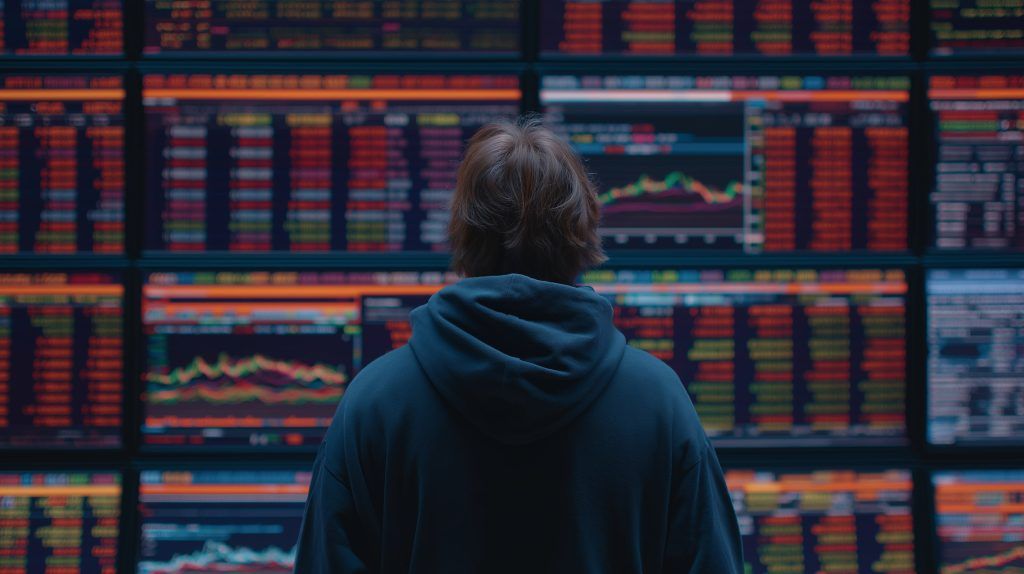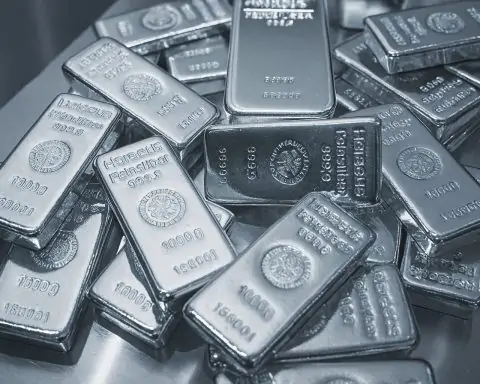- Sharp pullback: Gold prices sank below the $4,000 per ounce mark for the first time in weeks, tumbling to around $3,970–$3,988 on Oct. 27–28 – a steep drop from the record high of ~$4,381 reached just days earlier on October 20 [1] [2]. That’s roughly a 10% decline in about a week.
- Safe-haven rally stalls: The slide comes after a months-long gold boom. Geopolitical tensions (wars, trade conflicts) and economic worries had propelled gold up ~50–60% year-to-date in 2025 [3] [4]. Gold smashed through $4,000/oz for the first time ever in early October and kept climbing, vastly outperforming stocks and other assets [5].
- Why gold is falling now: Investors are engaging in profit-taking, and signs of easing U.S.-China trade tensionshave cooled demand for safe havens like gold [6]. A stronger U.S. dollar has also made gold pricier for overseas buyers, dampening buying interest [7] [8]. The result: a rapid correction after gold’s record run.
- Stocks & silver hit too: The sell-off has hit gold mining stocks – an index of precious metal miners (e.g. Newmont, Kinross) has slid over 20% from its recent high [9]. Silver – which rallied in gold’s slipstream to a 14-year high – plunged about 5%, though it remains ~56% higher in 2025 [10] [11]. Some investors even see the pullback as a potential buying opportunity to pick up gold equities at a discount.
- Outlook – dip or end of an era? Experts are split. Some analysts warn the gold rally was “too aggressive” and advise locking in profits now [12]. “This is a good time to convert paper profit into real profit. Aggressive profit booking is expected in gold and silver,” says Gautam Shah of Goldilocks Research [13]. However, many big banks remain bullish: institutions like HSBC and Bank of America predict gold could reach ~$5,000/oz by 2026 [14] given continued central bank buying, persistent inflation, and likely interest rate cuts. At the same time, some researchers are skeptical – Capital Economics just cut its 2026 gold forecast to $3,500/oz, arguing the recent 25% surge since August is hard to justify on fundamentals [15].
Gold’s Record Rally Meets a Sudden Drop
Only a week ago, gold was the year’s star performer – blasting through all-time highs above $4,300 per ounce. On October 20, spot gold hit an unprecedented ~$4,381/oz [16], capping a historic run fueled by global turmoil and investors seeking safety. By Oct. 27, that momentum dramatically reversed: prices plunged below $4,000 for the first time since early October [17]. In intraday trading, gold touched around $3,970/oz on Monday, the lowest level in three weeks, before settling near $4,002 by afternoon [18]. The swift drop marked gold’s steepest one-day slide in nearly 5 years, wiping out a chunk of the gains from its record peak [19].
Market watchers say the gold sell-off wasn’t entirely unexpected – after such a meteoric rise, a pullback was bound to happen. Since the start of 2025, gold had been on a one-way trajectory upward, rallying from roughly $2,650 in January to well above $4k by late October [20] [21]. Even after this week’s correction, the metal is still up roughly 50–60% year-to-date, on track for its strongest year since 1979 [22]. “Gold’s strength reflects an extremely positive macroeconomic and geopolitical background for safe-haven assets,” notes Matthew Piggott of Metals Focus, highlighting the anxiety that drove the metal’s rise [23]. In other words, 2025’s perfect storm of risks – war conflicts, inflation, recession fears – made gold shine as a safe-haven like rarely before.
That relentless record-breaking rally finally hit a wall. By last week, technical indicators showed gold was “overbought,” raising the risk of a snap correction [24]. Once sentiment shifted, the downturn was swift. Spot gold’s one-day fall over 3% on Oct. 21 was the worst since 2020 [25], and the losses extended into this week as sellers continued to lock in profits.
Trade Truce and Strong Dollar Cool Safe-Haven Demand
What triggered the plunge? A major factor is the tentative thaw in U.S.–China trade tensions. Over the past year, escalating trade conflicts and tariff wars had been a key driver sending investors into gold for protection. But in late October, the narrative flipped: Washington and Beijing suddenly signaled progress toward a trade deal. Negotiators outlined a framework to pause new U.S. tariffs and delay China’s export restrictions on rare earth metals [26] [27]. U.S. President Donald Trump and China’s President Xi Jinping are even set to meet this Thursday to discuss a broader accord [28].
This dimmer “fear factor” reduced the appeal of hiding in gold. “A potential U.S.-China trade deal portends a little less need for safe-haven assets such as gold,” explains David Meger, director of metals trading at High Ridge Futures [29]. Simply put, when the world looks a bit less scary – even temporarily – investors feel braver about owning riskier assets, and the urge to park money in gold declines.
At the same time, the U.S. dollar has strengthened, adding more pressure on gold. Since gold is priced in dollars globally, a rising dollar makes gold more expensive for buyers using other currencies, which can hurt demand [30]. That’s exactly what happened: as hints of a trade truce emerged, the dollar index ticked up, and gold – a non-yielding asset – became relatively pricier and less attractive. “In addition to technical selling, gold is seeing a further decline because of an unwinding of trade tensions that had taken prices from $3,800 to $4,400,” notes Jeffrey Christian of CPM Group, pointing out how easing trade fears reversed some of gold’s October gains [31].
Moreover, some of gold’s big seasonal buyers stepped back. In Asia, India’s festival season buying spree (ahead of Diwali) faded by late October, removing another pillar of support [32]. With fewer immediate catalysts to push prices higher, traders took profits en masse. The result: a rapid fall from the highs, as both speculative and safe-haven demand temporarily dried up.
Despite this pullback, it’s worth noting that gold’s broader uptrend may not be broken. Many underlying drivers – from geopolitical conflicts to central bank buying – are still in play (more on that below). Analysts at ActivTrades emphasize that the latest drop is largely a function of dollar strength and profit-taking, rather than a fundamental trend change. A stronger dollar “makes gold in other currencies more expensive – which douses demand. However, [we] do not see this as a sustained trend reversal,” the ActivTrades team commented [33]. In other words, the “fear of missing out” rally may have been dented, but the factors that made gold a star in 2025 haven’t vanished overnight.
Gold Stocks Slump – A Golden Buying Chance?
The impact of gold’s downturn has rippled into equity markets, particularly gold mining stocks. After thriving on soaring metal prices earlier in the year, miners have been hit by the sudden shift in sentiment. Newmont Corporation, the world’s largest gold miner, saw its stock fall ~5% this week and just reported quarterly earnings that underwhelmed expectations (as higher costs and the gold price pullback bit into margins). Fellow miner Kinross Gold and others have similarly slumped. In fact, a precious metals stock index tracking major gold producers like Newmont, Hecla and Kinross is now down over 20% from its peak [34] – officially entering “bear market” territory after an explosive run-up.
For long-term gold investors, though, this correction in miners could be enticing. The German investing magazine Der Aktionär even posed the question of a “golden entry chance” after the pullback [35]. The logic: if you believe gold’s bull run will resume, top-quality mining firms are now available at a relative bargain compared to a month ago. Indeed, some traders suspect that “the latest pullback will be seen as a buying opportunity” for those who missed the first leg of the rally. Bargain hunters are eyeing beaten-down mining shares, anticipating that any stabilization or rebound in gold prices could quickly revive the sector’s fortunes.
Of course, much depends on where gold goes from here. Mining stocks are levered to the price of bullion – they tend to fall harder than gold on the way down, but also surge higher if the metal rebounds. It’s a high-risk, high-reward bet on a continued gold boom. For now, companies are still enjoying windfall profits from gold’s earlier records (many miners were producing gold at far lower costs, so $4,000/oz prices translate to fat profit margins). Industry analysts expect record 2025 earnings for some producers and hefty returns to shareholders if gold stabilizes near current levels [36]. But in the short term, volatility in gold is making for a bumpy ride in mining equities – underscoring that even “safe havens” can swing wildly.
Meanwhile, silver, gold’s precious sidekick, has mirrored the drama. Silver prices had skyrocketed alongside gold, hitting an all-time high around $54.5/oz in mid-October [37] amid frenzied demand. Now silver too has recoiled: it fell about 3–5% this week to roughly $46–47/oz [38] [39]. Like gold, silver remains way up in 2025 (over +65% YTD [40]), and its outlook is bolstered by both safe-haven appeal and industrial uses (e.g. solar panels, electronics). Analysts have actually revised silver forecasts upward for next year – expecting an average of $50/oz in 2026, which would be fresh record territory [41]. The recent pullback hasn’t shaken the view that silver’s fundamentals (including supply deficits) are strong. But short term, silver will likely take cues from gold’s directional moves and overall investor risk appetite.
What’s Next: Correction or Continued Climb?
The big question on every gold investor’s mind: is this drop just a healthy correction on the way to even higher highs, or the start of a longer slide? On this, opinions diverge sharply.
On one side are the cautious voices. They point out that gold’s rally since summer was exceptionally rapid – perhaps too much, too fast. “The 25% jump in prices since August is much more difficult to justify than previous moves,” writes research firm Capital Economics, which just cut its gold price forecast and now sees gold at only around $3,500/oz by the end of 2026 [42]. Their view is that gold got ahead of itself on hype and fear, and could pull back further as the initial panic over various crises eases. Some technical analysts also note that if gold can’t quickly regain the $4,000 level, momentum sellers may push it down to the next support area (around $3,800 or even $3,600) before finding a floor [43]. The risk, they argue, is that sentiment has flipped – if traders believe the peak is in, the rush for the exit could continue in the short term.
Experienced market strategists advise prudence. “Each explosive run-up is likely to be followed by a pullback,” reminds one analysis [44]. The recent spike in gold had elements of FOMO (fear of missing out), as investors piled in on headlines of record highs. Now that the rally has cracked, those late buyers could capitulate. Gautam Shah of Goldilocks Research recommends taking some money off the table after such a big move, warning that profit-taking in both gold and silver was not only expected but prudent [45]. In essence, the correction might have further to go before gold finds equilibrium.
On the other side, many bulls remain undeterred. They see the current dip as a temporary pause – even a necessary breather – in a longer-term uptrend. The factors that drove gold to $4k haven’t disappeared: stubborn inflation, geopolitical instability (from the Middle East to Eastern Europe), and the prospect of easier monetary policy all still loom large [46] [47]. In fact, the U.S. Federal Reserve is widely expected to cut interest rates soon – possibly starting as early as this week’s Fed meeting [48]. (Futures markets put the odds of a Fed rate cut at about 97% for the October meeting [49].) Lower interest rates tend to benefit gold by reducing the appeal of interest-bearing assets and keeping “real” yields (after inflation) low [50]. If the Fed indeed pivots to rate reductions to support a cooling economy, that could reignite gold’s appeal in a big way.
Another bullish pillar: central banks are still on a gold-buying binge. Nations from China to Poland have been voraciously adding to gold reserves in an effort to diversify away from the U.S. dollar. Central banks have purchased over 1,000 tons of gold annually in recent years – a pace unprecedented in modern times [51] [52]. This official sector demand provides a steady underpinning to the market. As long as central banks (and large institutional investors via ETFs) keep accumulating gold, any price dips could be met with fresh buying [53]. Indeed, about $64 billion has flowed into gold-backed exchange-traded funds so far in 2025, an “unprecedented” influx reflecting strong investor appetite [54].
Big Wall Street banks are largely siding with the bulls. HSBC, Bank of America, and others have raised their gold price targets, some seeing the metal hit $5,000 per ounce within the next year or two [55]. A new Reuters poll of 39 analysts even projects gold will average $4,275 in 2026 [56] – implying that record territory above $4k could become the “new normal.” “Gold’s winning streak is seen extending into next year, with an average price above $4,000 for the first time, as economic and geopolitical turmoil keep its safe-haven allure intact,” that survey concluded [57]. Bulls argue that structural factors – like a broad loss of confidence in governments and currencies – are at play. “The market is no longer responding to short-term shocks but to a deeper loss of confidence in policymakers, currencies, and the financial system itself,” observes David Russell of GoldCore, noting how investors are increasingly treating gold as essential insurance [58] [59]. From this perspective, the gold rally isn’t just a flash in the pan; it’s part of a larger secular shift.
Bottom line: The recent gold plunge has jolted the market, but it hasn’t definitively ended gold’s time in the sun. In the near term, a lot depends on whether upcoming events reassure investors or spook them anew. A successful U.S.-China trade deal or easing of geopolitical conflicts could keep gold on the back foot. Conversely, any negative surprises – say, a flare-up in a conflict or a central bank policy misstep – could quickly send traders running back to bullion. As we head into the final months of 2025, gold finds itself at a crossroads: hovering near $4,000, caught between an ebbing tide of immediate fear and the long-term forces that many believe will continue to burnish its shine.
For now, gold holders can take solace that the metal’s haven status is intact. Even after this pullback, 2025 has been a banner year for gold, and many seasoned investors maintain positions as a hedge against the unknown. Whether this is a brief dip before the next climb or the start of a longer cooldown, gold will be closely watched. History has shown that each time gold’s record rally pauses, it eventually comes roaring back – but also that vigilance is warranted when markets turn euphoric. As one strategist put it, gold “can correct sharply, even in a bull market” – and that often opens opportunities for those who kept some powder dry [60]. In the end, the gold bugs and the skeptics will both have their say; the only certainty is that this wild gold ride isn’t over yet.
Sources: Recent market data and expert commentary from Reuters, dpa reports and financial media [61] [62] [63], TechStock² (TS2) analysis [64] [65], and statements by industry analysts and strategists [66] [67].
References
1. www.reuters.com, 2. www.aktiencheck.de, 3. www.aktiencheck.de, 4. ts2.tech, 5. ts2.tech, 6. www.reuters.com, 7. www.t-online.de, 8. ts2.tech, 9. www.aktiencheck.de, 10. www.aktiencheck.de, 11. ts2.tech, 12. ts2.tech, 13. ts2.tech, 14. ts2.tech, 15. www.reuters.com, 16. www.reuters.com, 17. www.reuters.com, 18. www.reuters.com, 19. ts2.tech, 20. ts2.tech, 21. ts2.tech, 22. www.reuters.com, 23. ts2.tech, 24. ts2.tech, 25. ts2.tech, 26. www.reuters.com, 27. www.reuters.com, 28. www.reuters.com, 29. www.reuters.com, 30. www.t-online.de, 31. www.reuters.com, 32. ts2.tech, 33. www.t-online.de, 34. www.aktiencheck.de, 35. www.aktiencheck.de, 36. de.marketscreener.com, 37. ts2.tech, 38. www.aktiencheck.de, 39. www.reuters.com, 40. www.reuters.com, 41. www.reuters.com, 42. www.reuters.com, 43. finance.yahoo.com, 44. ts2.tech, 45. ts2.tech, 46. ts2.tech, 47. ts2.tech, 48. www.reuters.com, 49. www.reuters.com, 50. ts2.tech, 51. web.de, 52. ts2.tech, 53. ts2.tech, 54. ts2.tech, 55. ts2.tech, 56. www.reuters.com, 57. www.reuters.com, 58. www.reuters.com, 59. www.reuters.com, 60. ts2.tech, 61. www.reuters.com, 62. www.aktiencheck.de, 63. ts2.tech, 64. ts2.tech, 65. ts2.tech, 66. www.reuters.com, 67. www.reuters.com










